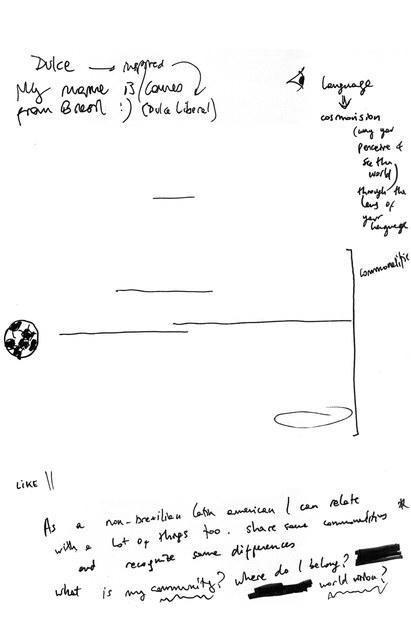
4 minute read
What makes brasil, Brazil?
I began to work on the concept of Escola Aqui’s well before its debut at SVA’s MFA in Fine Arts program. At the time, I was angry and confused due to the recent changes in my home country’s political environment3 paired with my new social status as an immigrant in the United States during the Trump administration. I felt the need for my artwork to incorporate an understanding of these shifts. Feeling the distance, discomfort, intimidation, underappreciation, and dread of not fitting in a country (neither here nor there), I was materially, emotionally, and psychologically invested in learning about and digesting my new living situation. I started to create images using terms related to these matters and it was then that I remembered a book about Brazilian culture introduced to me over twenty years ago during my undergrad studies in Social Sciences. I was compelled to review it.
O que faz o brasil, Brasil? (What makes brasil, Brazil?) was written by the Brazilian anthropologist Roberto DaMatta. From this comes the title of my first pr oposal for a study group at Escola Aqui, which involved Brazilian and Brazilian-American women living in New York. Acknowledging their particularities as either immigrants or first-generation citizens, I invited them to share their thoughts and feelings with me through activities based on DaMatta’s excerpts. Our meetings in Portuguese occurred weekly in my studio at SVA from the last quarter in 2019 to March 2020.
Advertisement
It was special and significant to have these women from the outside brought into this renowned art school, making the studio their own, drinking coffee, eating paçocas4, talking loudly, even disrupting the floor a bit, and occupying the space. A group of people that can identify, like anyone else, what the text I proposed was about. However, we debated nuances and brought new layers of meaning to the readings that only we in particular, and at that time, could do.
ESCOLA AQUI
25
Later on, another two random groups were formed by a more diverse assembly of guests (not just women, and not just Brazilians). They attended pop-up events that I set up in another space that was not my studio as I experimented with the project’s nomadic aspects. Those gatherings were hosted in English and happened right before the COVID-19 lockdown in 2020.
During each session, I proposed the same DaMatta readings I had used for the previous weekly meetings. Guests had fifteen minutes to read through and work on the texts. After that, using black ink pens over the printed plain white paper, everyone transformed the original text through underlines, overwrites, diagrams, and additions of words. Explaining their thoughts, participants shared questions and opinions. Some guessed the meaning of cultural identities, and others opposed themselves to this notion as a whole, even negating the concept of countries in general. In both circumstances, we practiced generous listening and attentive engagement. At the end of the exercise, there was no longer any direct access to DaMatta’s ideas.
I then collected the various interpretations and opinions in the form of images and sounds. I worked on texts as drawings and put them together with the audio I had recorded of the discussions and readings. From there, I developed what makes brasil, Brazil (20192020), a multi-channel video installation and a sound piece, both available on the project’s website.
The video installation, while online, is also interactive. Viewers can play and zoom in on each channel, see the drawings that participants made, and listen to their voices. On the other hand, the sound piece overlaps the complete set of speeches that I documented and edited to become somewhat loud and noisy in the beginning, slowly giving way to a sole female Brazilian voice, reciting her own bilingual readings in the end.
26
ESCOLA AQUI
Escola Aqui
Activation occurred on February 27, 2020. In the photo: Dani and James. In the foreground are covers of the books What makes brasil, Brazil? by Roberto DaMatta and Goodbye Brazil by Maxine Margolis. Ativação ocorrida em 27 de fevereiro de 2020. Na foto: Dani e James. Em primeiro plano capas dos livros “O que faz o brasil, Brazil?” de Roberto DaMatta e “Goodbye Brazil” de Maxine Margolis.
27

what makes brasil, Brazil, 2019-2020
Detail | Detalhe Video still | Still de vídeo 02’42”

what makes brasil, Brazil, 2019-2020
Detail | Detalhe Video still | Still de vídeo 01’01”

what makes brasil, Brazil, 2019-2020
Detail | Detalhe Video still | Still de vídeo 01’21”

what makes brasil, Brazil, 2019-2020
Detail | Detalhe Video still | Still de vídeo 01’22”




what makes brasil, Brazil, 2019-2020
On the previous page: a screen capture detail of the multichannel video installation on the project website. Na página anterior: detalhe de captura de tela da instalação de vídeo multicanal no website do projeto. Available at | Disponível em: https://carolinapaz.com/what-makes-brasil-brazil/










